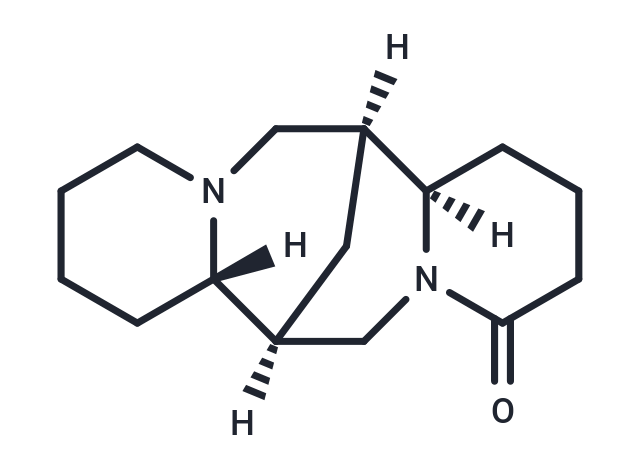Shopping Cart
- Remove All
 Your shopping cart is currently empty
Your shopping cart is currently empty

Lupanine ((+)-Lupanine), a naturally occurring quinolizidine alkaloid, potently affinity and activates nicotinic acetylcholine receptor (nAChR) (Ki=500 nM), and shows significant neuroprotection against soluble amyloid β-oligomers (SO-Aβ) toxicity in cellular models in association with the anti-apoptotic PI3K/ Akt/Bcl-2 signaling pathway with anti-Alzheimer's disease potential. Improves glucose homeostasis by affecting KATP channels and enhancing insulin secretion with therapeutic potential for type 2 diabetes.

| Pack Size | Price | Availability | Quantity |
|---|---|---|---|
| 5 mg | $1,309 | 6-8 weeks | |
| 25 mg | Inquiry | 6-8 weeks | |
| 50 mg | Inquiry | 6-8 weeks | |
| 100 mg | Inquiry | 6-8 weeks |
| Description | Lupanine ((+)-Lupanine), a naturally occurring quinolizidine alkaloid, potently affinity and activates nicotinic acetylcholine receptor (nAChR) (Ki=500 nM), and shows significant neuroprotection against soluble amyloid β-oligomers (SO-Aβ) toxicity in cellular models in association with the anti-apoptotic PI3K/ Akt/Bcl-2 signaling pathway with anti-Alzheimer's disease potential. Improves glucose homeostasis by affecting KATP channels and enhancing insulin secretion with therapeutic potential for type 2 diabetes. |
| In vitro | Lupanine (0-100 μM) treats SH-SY5Y cells with EC50 and DC50 values of 10.7 μM and 28.2 μM, respectively. [2] |
| In vivo | Methods: Lupanine (20 mg/kg, orally) was administered to non-diabetic and diabetic rats, and an oral glucose tolerance test was performed 30 minutes later. Results: Lupanine reduced blood glucose concentrations and improved glycemic control in an in vivo diabetic rat model. [3] |
| Alias | D-Lupanine, (+)-Lupanine |
| Molecular Weight | 248.36 |
| Formula | C15H24N2O |
| Cas No. | 550-90-3 |
| Smiles | O=C1N2[C@@]([C@]3(C[C@@](C2)([C@]4(N(C3)CCCC4)[H])[H])[H])(CCC1)[H] |
| Relative Density. | 1.16g/cm3 |
| Storage | keep away from direct sunlight | store at 4°C | Shipping with blue ice. |

Copyright © 2015-2025 TargetMol Chemicals Inc. All Rights Reserved.